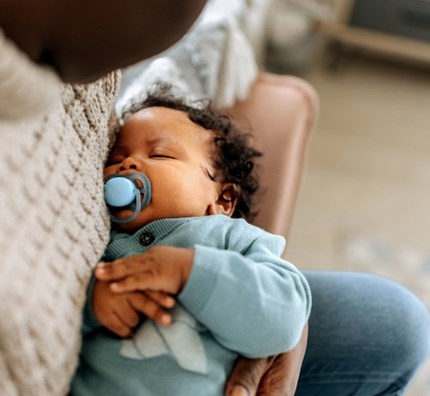“I slept like a baby.” Exhausted new parents may be confused by what this old saying really means.
Babies do sleep a lot, but they sleep for shorter spans of time, often in two- to four-hour increments. That’s why parents may find themselves up at night, pacing and wondering when their little one will go back to sleep.
Sleep is essential to development from the moment a child is born. Sleep behaviors and patterns shift significantly in a child’s first year, so it’s important for parents to be aware of their baby’s changing needs.
Age is a big factor
Age plays a major role in how many total hours of sleep children need. Newborns need the most, and sleep needs slowly decrease as children age. Stanford Medicine provides these guidelines:
|
Age |
Total hours of sleep |
|
Newborn |
16-17 hrs. |
|
1 month |
15.5 hrs. |
|
3 months |
15 hrs. |
|
6 months–1 year |
14 hrs. |
|
1.5 years |
13.5 hrs. |
|
2 years |
13 hrs. |
Not only does total sleep change, but children of different ages also spend their sleep hours very differently. For example, a newborn sleeps in short one-to-three hour sessions during the day, and in three-to-four hour sessions at night.
As the months go, a baby’s sleep schedule becomes more regular. By 12 months, babies need less total sleep and more of their sleep takes place over longer sessions at night.
Sleep is a learned skill
One reason an infant’s sleep behavior changes so much in the first year of life is because babies sleep without any sense of an adult’s schedule. Eventually, babies adapt to the daytime and nighttime patterns of the grownups in their home.
Parents can help children learn how to how to fall asleep on their own and guide their child’s sleeping pattern by knowing the signs of sleep readiness and establishing good habits around bedtime.
Some signs of sleep readiness in an infant are:
- Yawning
- Fussing
- Rubbing their eyes
- Looking away
When you’re aware of your baby’s signs that they’re ready for sleep, you can start helping them learn to fall asleep on their own.
Ways to help your baby learn to fall asleep
Parents know that falling asleep isn’t always an easy next step, no matter how tired a child may be. Creating bedtime routines can help your baby wind down and fall asleep.
Some bedtime routines that you can try include:
- Making things calm and quiet just before bedtime.
- Playing soft music when a baby starts showing signs of sleep readiness.
- Comforting them at bedtime by patting and soothing them—but without picking them up or taking them out of bed.
- Offering your child an object that signals it’s time to go to sleep—something like a small blanket or stuffed toy. For safety, only do this after your baby is old enough to roll and sit.
The University of Rochester Medical Center encourages parents to keep these things to keep in mind as they try to help a baby fall asleep:
- Your bedtime routine should NOT INCLUDE having your baby fall asleep in your arms. While many parents will rock or breastfeed a baby to ease them into sleep, these practices may lead a baby to need those thing in order to fall asleep.
- Cuddling and comforting your baby during the day can help them feel more secure about going to sleep at night. Babies may be less worried about nighttime separation when they feel more secure.
Remember your ABCs
When helping your child fall asleep, remember the ABCs of safe sleeping habits -
- A-Alone
- On their B-Back
- In a C-Crib
Self-soothing to fall back asleep
Often, parents hear that they should let babies cry a bit and try to fall back asleep on their own. A baby’s ability to quiet themselves and fall back asleep is referred to as self-soothing.
When a baby wakes in the night, The University of Rochester Medical Center suggests parents try this approach to encourage self-soothing:
- Go to the baby’s crib, pat and comfort the baby without picking them up and taking them out of bed. Say good night and leave.
- If your baby cries after you leave, wait a few minutes, then return and comfort your baby again. Stay for a while, reassure with patting, but still avoid holding them or taking them out of bed.
- Continue this process as needed, until the baby falls asleep.
The thinking is that when parents are consistent about how they respond, it becomes easier for babies to soothe themselves, go to sleep, and fall back asleep when they wake up.
The age at which a baby can handle self-soothing varies, with some research showing the ability to self-soothe develops as late as 8 or 9 months. That means parents will have to notice what helps their child and use their best judgment.
It’s also important to remember that babies may cry and have trouble sleeping because they’re hungry, need a diaper change, are sick or uncomfortable. If a baby is crying and unable to be soothed back to sleep, consider what might be causing the behavior.

Sleep is essential to development from the moment a child is born. Sleep behaviors and patterns shift significantly in a child’s first year, so it’s important for parents to be aware of their baby’s changing needs.
